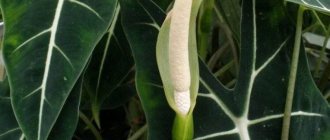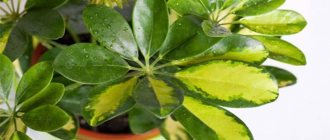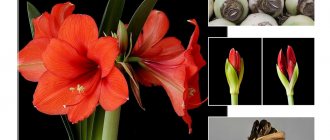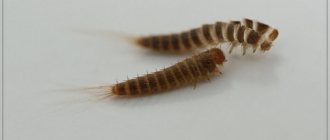- November 23, 2018
- Planting
- Olya Bodrova
Dieffenbachia is very familiar to many indoor flower lovers. A beautiful single-stem plant with unevenly colored leaves can decorate any home. The flower will bring a certain sophistication and imposingness to an inexpensive interior, and will fit into the decor of a fashionable office, as if it was created for this purpose.
General characteristics
To find out exactly which soil will be the best for Dieffenbachia, you need to understand other features of the plant. The flower's homeland is the Pacific Islands and southern North America. In nature, the plant can reach six meters in height, but in apartment conditions it rarely grows above two meters. The shape and color of the leaves depend on the variety.
The plant is recommended to be grown in rooms facing highways, factories, factories or railways, since Dieffenbachia perfectly purifies the air. However, the plant is poisonous and can cause swelling of the larynx or irritation of the skin and mucous membranes upon direct contact with the juice. Based on this, in a house where there are small children or animals, the flower should be placed in a fairly protected place. In indoor conditions, the plant practically does not bloom, but it can produce a bud in early spring. It is especially poisonous, as are the bright berries that appear on Dieffenbachia afterwards.
How to grow luxurious Dieffenbachia
What do you think the apartments of Russians have in common with American countries? First of all, this is vegetation. After all, many of the plants that we grow actively grow in the tropics, which are their homeland. One of these “newcomers” is Dieffenbachia, beloved by many. Today we invite you to learn how to grow gorgeous Dieffenbachia at home.
Dieffenbachia in the interior
Dieffenbachia fits perfectly into the interior, and its large spotted leaves give the apartment a tropical charm. Compared to other plants, Dieffenbachia is quite large. With proper care, in about 3 years it can grow to the very ceiling. Despite the fact that Dieffenbachia is a representative of the leaf family, nothing beautiful is alien to it. Being in a good mood, thanks to your care, she can please the eye with beautiful blooms.
Note that the juice of this plant is poisonous. Therefore, families with children or owners of pets need to be careful, making sure that the latter, of course, do not feast on a Dieffenbachia leaf. Simply touching it will not cause any harm, but after this you should wash your hands thoroughly with soap. It is better to place the plant where neither children nor our little brothers can reach it.
At the same time, the large-leaf plant itself can benefit humans. It releases copious amounts of oxygen and ionizes the airspace. In addition, Dieffenbachia leaves help increase air humidity in the apartment, as they evaporate a large amount of water located on their surface.
Lighting
This plant welcomes bright and warm rooms. But it should not be exposed to direct sunlight: ultraviolet radiation can burn and harm the delicate leaves of Dieffenbachia. Ideally, grow it near a window, but not on the windowsill itself, but near it, fencing it off with a curtain made of light, slightly transparent fabric. To prevent the variegated pattern on the leaves from fading in winter, additional lighting will be required, for example, using a lamp. Unfortunately, the winter sun is not able to preserve the full beauty of this flower. If there is no backlight, nothing critical will happen, but the leaf pattern may not be so noticeable.
Air humidity and temperature
Dieffenbachia extremely does not like sudden changes in temperature, drafts and cold - after all, it comes from warm areas. It is important that the flower does not freeze in winter. Otherwise, the roots may begin to collapse and rot. Try to ensure that the temperature in the apartment where Dieffenbachia lives never drops below 17 degrees. When it’s warm outside (and even more so hot), it is recommended to pamper Dieffenbachia with spraying. She will only be happy with a daily shower from a spray bottle. Also, in hot weather, it is advisable to regularly wipe the leaves, but in the fall and winter, give them a rest. In cold weather, Dieffenbachia should not be sprayed more than 2-3 times a week.
Feeding and watering
As you probably already guessed, Dieffenbachia loves water. In the warm season, the plant requires abundant watering. Do not let the soil dry out - this can lead to the death of the plant. As soon as the top soil layer dries, immediately moisten it. But you don’t need to water it with ice water: she likes to drink, but not freeze. In the warm season, use water at room temperature for irrigation, and in cold weather, slightly warmed water.
Plant varieties
The most common types of flower are Dieffenbachia Seguina and spotted. The first is decorated with a marble pattern on dark green leaves with veins, streaks and spots. The leaves can reach 60 cm in length with proper care and provided that the soil for Dieffenbachia is selected taking into account all requirements.
The foliage of the second popular variety is decorated only with spots and specks of ivory color on a dark green background. Sometimes the pattern can merge, forming a completely lightened center on the surface of the sheet. The size of the oval leaves with proper care reaches 70 cm.
Less common among domestic connoisseurs of indoor flowers are Dieffenbachia Baumann, Bauze and Oersted. Their leaves have a unique pattern and shape, and the height of the entire plant can vary from 80 cm to one and a half meters.
Rules of care
If the new owner received the flower already planted, then you will need to worry about what kind of soil Dieffenbachia needs only after some time. First you need to provide the plant with proper care in its current form with the existing soil.
So, you need to place the container with the flower in the back of the room to protect the plant from direct sunlight and overheating from the window. Also, the plant does not tolerate drafts and fresh air flows, therefore, if there is no space in the room to protect the flower from this, it should be taken out to the next room for ventilation. The pot needs to be rotated from time to time to ensure uniform illumination of the bush from all sides. When the plant becomes cramped in its current container, you need to take care of a new pot and soil for Dieffenbachia.
Dieffenbachia transplant at home
It is known that Dieffenbachia does not bush on its own, but grows tall.
To give it the shape of a bush, you have to do quite a lot of pruning and replanting.
But before transplanting Dieffenbachia, you must first understand the reasons why this procedure may be required:
- the owner of the flower simply wants to improve its appearance;
- The size of the plant does not correspond to the volume of the pot in which it is located.
If you delay replanting, the flower may begin to hurt and lose its leaves. Finding out when the time has come for this procedure is very simple. To do this, it is enough to monitor the behavior of the plant.
Signals for transfer
- Reduced growth rate.
- Quick drying of the soil in the pot after watering.
- Reducing the size of new leaves.
If a plant, the development of which is accompanied by similar symptoms, is removed from the pot, then you can find a root that has grown over the entire space. Before planting you need to prepare:
- new pot;
- materials for the drainage system;
- priming;
- water for irrigation.
The pot should be 2-3 cm larger than the old container.
Transfer
In the store you can purchase ready-made soil mixtures for indoor plants, but since all such mixtures consist of fibrous peat, you will still have to additionally enrich the purchased soil with humus. That is why it is better to prepare the soil for transplanting Dieffenbachia yourself. You will need to mix equal parts:
- peat;
- humus;
- leaf soil;
- sand.
It is also recommended to add a little birch charcoal to the resulting composition to cleanse the soil of harmful salts.
The plant will take root much faster in a new place if, when transplanting, its stem is buried a little into the ground and new roots are allowed to form. Also, no matter how nutritious the substrate is, in the first few days after transplantation it is necessary to add root growth stimulants to the container.
The plant experiences a little stress after changing the soil and pot, so after replanting the stem may become completely bare, dropping all the leaves. You should not be scared at this moment, you just need to cut off part of the trunk, leaving only a 10 cm stump with roots in the ground, from which new leaves will subsequently form. By the way, you can get a new plant from the top.
Since the plant is poisonous, you need to use protective equipment when transplanting Dieffenbachia into soil. In this case, the pot should be taken with a small reserve, the roots of the plant grow quickly.
What kind of pot does Dieffenbachia need?
Question: Does Dieffenbachia like a spacious pot or a cramped one?
Kroky: It grows so quickly, a spacious pot becomes cramped very quickly. Choose a spacious one - the available soil space can be about two to three times more than the root ball. Do not forget that Dieffenbachia is a powerful plant and the pot must be stable. But if you immediately take a very large pot (the space is 4-5 times larger than the root ball), then the risk of waterlogging increases. Therefore, in a large pot, be careful with watering, or make a higher drainage layer.
Stem cuttings
If after dropping the foliage there is only a bare trunk left, then you can use it as future cuttings. To do this, leave a 10 cm stump with the roots, and cut off the rest of the trunk with a sharp knife. The resulting branch should be divided into several parts so that each has one node in the middle. The resulting cuttings should be slightly dried, sprinkled with coal, and planted in the substrate in the direction of stem growth.
The soil for Dieffenbachia propagated in this way should consist of sand and peat; if desired, supports can be built for the stumps. After planting and abundant watering, the cuttings should be covered with film, cut bottles or jars to create a greenhouse effect. Periodically, the cuttings need to be ventilated and wait until they take root. As soon as new leaves appear on the stems, the plants can be transplanted into separate containers with soil as for adult plants.
Dieffenbachia after pruning
Question: The trunk of my Dieffenbachia has begun to become bare. It's not very pretty. I want to plant a second one in this pot. Tell me, if I cut off the top and root it in water, what will happen to the mother plant. How will Dieffenbachia continue to grow without a crown?
polin: Without a crown - it will send out side shoots. That's all. I chop my healthy one like firewood every 2 years.
Alla Viktorovna: I also cut mine in half, the top took root in the water, and the stump produced a new shoot from the upper bud in the area of the “bridge” on the trunk. Now I have two Dieffenbachia!
Apical cuttings
In this way, only one new plant can be obtained from one old flower. To do this, during the period of shedding leaves, only the top of the trunk should be cut off and planted in prepared soil for Dieffenbachia. Its composition should be similar to the substrate prepared for stem cuttings. In order for the plant to be better accepted, its cut should be freed from the poisonous juice with a napkin and treated with phytohormones of growth before deepening. There is no need to create a greenhouse; you just need to regularly spray the plant with warm water, and within a couple of weeks new young leaves will appear on it. After this, the flower can be transplanted into a container for continuous growth.
Air layering
In this case, intermediate soil for Dieffenbachia will not be needed at all; the resulting sprouts can be immediately planted in a substrate for adult plants. This method of propagation is effective only when used from May to September and consists of the following:
- On a living flower stem, use a disinfected knife to make longitudinal cuts 5 mm below each leaf or eye.
- Next, a wet match or toothpick needs to be rolled in cutting powder and inserted into each cut so that it does not close and cannot be tightened.
- After this, each cut is carefully wrapped in damp moss and secured with film.
The first roots will begin to break through the moss only after 2-3 months. This is when parts of the stem with new root systems need to be separated and planted in a mixture for mature plants.
There is also a simplified version of this reproduction. After making the cuts, you do not need to use matches; you can simply wrap the wounds with moss and film, but then the emerging roots must first be planted in a container with a substrate for cuttings. Full soil for Dieffenbachia will be needed only when leaves appear on the new shoots and they can be replanted.
Dieffenbachia flowering
Question: Dieffenbachia grew just fine, then it began to bloom. I heard that flowers need to be removed?
polin: If Dieffenbachia starts to bloom and you want to see the flowering, then it just needs increased feeding. My bush bloomed. All the “oppression” was expressed in one sheet of smaller than usual size and that’s all. You just need mandatory weekly fertilizing with mineral and organic fertilizers during the flowering period and after it for at least a month. Then you can switch to the normal feeding mode.
If we proceed from the fact that when we need to support the foliage, we feed it where there is more nitrogen, i.e. as usual “for decorative deciduous trees”. But, since it still blooms, I did one feeding “for decorative flowering plants”, where there is more potassium and phosphorus.
What should be the volume of the pot? Where is the best place to put it? Where is it for you? Dieffenbachia macrophylla.
When selecting a pot for replanting, one is guided not by the size or type of plant, but by the volume of its root system. The size of the green ground mass may not correspond to what is underground.
One of the basic rules of indoor floriculture: the plant is not transplanted into a pot much larger than its root system.
Dieffenbachia at certain stages of its life has a different volume of the root ball, so no one can tell you the exact size of the pot in centimeters. This also applies to any other plants. Dieffenbachia in the form of a stem cutting with hatched roots will require a temporary (for 2-3 months) pot or a transparent disposable cup of 150 - 200 ml. As Dieffenbachia grows during transplantation, a new pot is selected annually (preferably in spring) 2-3 cm in diameter larger than the old one.
The root system of Dieffenbachia is fibrous, so low pots are selected for it. When replanting, you can use an approximate substrate for Dieffenbachia: universal soil (essentially a mixture of peat) from the store is mixed with perlite or vermiculite, and a little sand is added.
Indoors, Dieffenbachias are selected in a bright place with bright diffused or good artificial lighting. Without shading, Dieffenbachia can be grown on windows with an eastern or western orientation; in winter, southern ones are suitable. In an office where there are no windows, the plant is placed as close as possible to sources of artificial light (preferably fluorescent lamps), and the light is turned on for at least 8 hours a day. It is not advisable to grow Dieffenbachia in dark corners of rooms on northern windows - the plant will become depleted and grow too long and ugly stems.
Dieffenbachia is watered abundantly until the earthen clod is completely wetted. Between waterings, the soil should dry out by 1-2 cm in spring and summer on warm sunny days, and by 3-4 cm in the cool season. Constant dampness and overdrying of the soil are unacceptable.
Dieffenbachias are thermophilic and do not require frequent feeding.
One of the most popular indoor plants is Dieffenbachia.
Despite the fact that it comes from South America, it can be successfully grown at home.
In order for the plant to be healthy and enjoy its attractive appearance for a long time, it is necessary to provide it with proper care.
Transfer rules and times
The container for flower growth should be changed at least once every 3 years, since as the root system grows, the old pot will certainly become small over this period. Flower growers recommend carrying out this procedure annually. You can buy ready-made soil for Dieffenbachia, but you must add charcoal to it before direct use. In addition, throughout its growth, the plant should be additionally fed from spring to late summer with liquid complex fertilizers, since it is at this time that new leaves are laid and the health of the flower for the entire next year is determined.
The pot for transplanting must be high, but not too wide. A generous layer of drainage should be placed at the bottom. To prepare your own soil mixture, you can use the following recipe:
- 2 parts leaf soil;
- 1 part each of peat and sphagnum;
- 0.5 parts sand.
The top layer of soil must be loosened regularly throughout the year.
Transplantation is carried out by transferring a clod of earth from an old pot into a new container.
Dieffenbachia - reproduction
Question: Everyone’s Dieffenbachia cuttings easily take root in water, but mine drops leaves and rots?
Natali: In order for Dieffenbachia to take root safely in water and not rot (loss of leaves is quite acceptable), you need to take clean water, not boiled, but preferably filtered, add 4-5 tablets of activated carbon per half liter, do not keep the jar of water in the light ( You can wrap it in a napkin) and change the water periodically for fresh water. You can also root in a weak fertilizer solution. Any fertilizer for decorative foliage plants, taken in a dose 4 times less than recommended for root feeding.
If rotting (the bottom of the cutting becomes slimy and darkens) has begun, then you can cut off the damaged part of the stem to healthy tissue, rinse the cutting in running water, place it in fresh water, to which add a few drops of phytosporin. After 2-3 days, replace the water with fresh water, add phytosporin again, but 2 times less. If there is no phytosporin, add ground cinnamon on the tip of a knife.
If Dieffenbachia is rooted in the ground, then it does not need to be covered with a bag or jar, but the cuttings must be sprayed 2 times a day. And the soil should be kept only slightly moist. Of course, the soil should be sterilized (soak it in the microwave for about 3 minutes), and the cut of the cutting should be sprinkled with crushed charcoal.
Caring for Dieffenbachia - in the section of the Encyclopedia of indoor plants.
Kroky: A possible reason for the trunk rotting in water is the cut touching the bottom of the jar. Try to arrange it somehow so that the cut hangs in the water. You can also sprinkle the cuts with charcoal. The leaves, by the way, have the right to turn yellow and fall off in the process, don’t be alarmed. And cuttings from the trunk need 2-3 rings.
aie13: I root exclusively in water: a 3-liter jar of boiled water + 5 tablets of activated carbon, I wrap the jar with a black garbage bag (so that it is dark in the jar). The crown in the cut-off state is usually about a meter long, I dry the cut for 2-3 hours and put it in a jar, it was very correctly noted earlier that the cut should not touch the bottom - otherwise 50% of the decay is inevitable. After 3-4 weeks, small roots appear - now into the ground. Inevitably I lose a few of the lower leaves.
Question: I’m trying to root a Dieffenbachia cutting, but nothing is working!
Reproduction of Dieffenbachia - in the section Popular indoor plants
polin: When rooting Dieffenbachia cuttings, I noticed an interesting trend - if the cutting is apical, then the roots take longer to appear than if the cutting is cut from the middle of the trunk (without the top). Maybe with two tops the rooting process is naturally delayed?
Kroky: Indeed, the higher up the trunk, the longer the roots take to grow. In root cuts, roots can appear within a week. Therefore, there is little point in comparing the rate of root appearance in different people. Even on thin, recently grown shoots, roots will also appear faster than on old, thick ones. But the latter will develop large leaves faster.
Lelya: My stalk (it has dropped all its leaves) has been sitting in the water for about 20 days and only now a tubercle has appeared and a hint of a new leaf.
Elena: I rooted Dieffenbachia twice. The first time in the ground under a jar, the second time in water with activated carbon. The second method is much easier; my Dieffenbachia took root in two weeks.
Features of care
Illiterate care is most often the cause of various problems with the plant. The decorative appearance of the flower is lost when the owner does not know what kind of soil Dieffenbachia likes, how and when to water it correctly, and does not follow the recommendations for lighting and placement of the pot in the apartment.
If the leaves on a flower begin to turn yellow or dry out, then the plant must be urgently removed from a source of cold air, a draft, or from a place with large temperature changes. Of course, first of all, before doing this, everyone needs to check the soil moisture status. The plant loves moisture; during the growing season it needs to be watered regularly and abundantly. It is also recommended to spray the flower leaves with soft water more often.
When the leaves become spotted or change color to a paler color, the flower must be removed from direct sunlight or just a place with bright light.
If the leaves begin to fall at an uncharacteristic time, then the flower is cold and the temperature regime needs to be changed. In summer, Dieffenbachia needs 18-24 degrees, and in winter 17-19 degrees. If all other care requirements are met, the plant tolerates a temperature increase of several degrees well.
Dieffenbachia stretched out
Question: My Dieffenbachia has an elongated trunk and very long petioles, what could this be connected with? I can't wait to cut it, except it's winter now.
Gray: They are elongated because she clearly doesn’t have enough lighting! Now is not the best time of year for houseplants. It's a bit dark. Either move it closer to the window, or arrange additional lighting. Hang a regular fluorescent lamp and add light in the evening. For example, this is what I do: I illuminate many plants until 24 pm. If you move it closer to the window, then pay attention to the radiators. Dieffenbachias do not like dry air, like all other plants. So, it is necessary to humidify the air in the room to increase humidity! No need to cut now! Still, wait until spring, when all plants begin their growing season. Transplantation is also advisable in the spring. There is no need to cause additional stress to the plant.
Diseases and pests
Often it is the soil for Dieffenbachia that is the cause of its disease. This happens when the soil is infected with fungal infections or viruses. The painful state of the plant is recognized by uncharacteristic spots or stripes on the leaves, yellowness, drying or weeping edges of the foliage.
Most often, the plant is affected by fusarium, anthracosis and viruses. To cope with fungal diseases, it is necessary to treat the flower with fungicides, normalize the living conditions and remove the diseased parts of the plant. It is also recommended to transplant the Dieffenbachia into a new, disinfected pot and soil.
If the leaves begin to curl and acquire a bronze tint, then the flower is affected by a viral disease. It is impossible to get rid of it; the plant will have to be thrown away, and taking propagation material from it is prohibited.
Among the pests, the poisonous plant is eaten by scale insects, aphids, spider mites and mealybugs. Spraying with soapy water and insecticides helps get rid of them. In some cases, tobacco infusion, green soap and compositions with a slight addition of denatured alcohol and kerosene are used.











